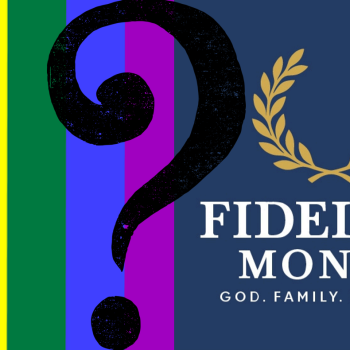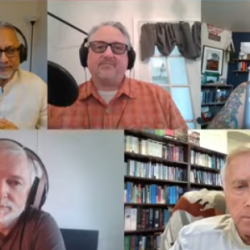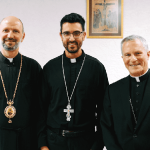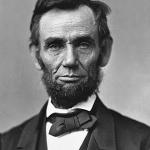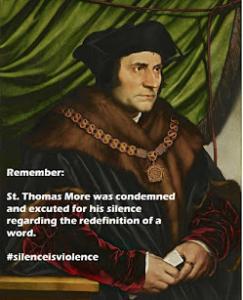 What is the cost of silence? On the 6th of July, 1535, a head appeared atop a pole on London Bridge. Put on display as a warning to all of England—consent to the king or this WILL be your fate. This head belonged to one of the most respected men in Europe—Sir Thomas More. He died for refusing to take an oath, for this oath contained a redefinition of a term that he could not in good conscience consent to. The term: supremacy. In wanting to put aside his first wife, King Henry VIII redefined the ecclesial meaning of the word “supremacy” by removing the Pope and inserting himself in his place.
What is the cost of silence? On the 6th of July, 1535, a head appeared atop a pole on London Bridge. Put on display as a warning to all of England—consent to the king or this WILL be your fate. This head belonged to one of the most respected men in Europe—Sir Thomas More. He died for refusing to take an oath, for this oath contained a redefinition of a term that he could not in good conscience consent to. The term: supremacy. In wanting to put aside his first wife, King Henry VIII redefined the ecclesial meaning of the word “supremacy” by removing the Pope and inserting himself in his place.
Who was Thomas More?
Thomas More was an English Catholic humanist intellectual and politician whose most influential years encompassed the first thirty years of the 16th century. Elected to Parliament in 1504, undersheriff of London (1510), Privy Counsellor (1514), Speaker of the House of Commons (1523), and Lord Chancellor (1529). As a writer, he penned many diverse works, including the infamous Utopia in 1516. A man who in 1503 considered joining the Carthusian monastery, was THE most respected and THE second most powerful man in England by 1529. Regardless of the respect of peers like Erasmus of Rotterdam and the ear of King Henry VIII.
Thomas More was neither a proud nor haughty man. He viewed his charge as from God and to God he was ultimately accountable. By all accounts, this was truly a great man.
Trouble for Thomas
 The trouble for Thomas started because the King of England, Henry VIII, was unable to produce a son and heir with his Queen Catherine of Aragon. He therefore desired an annulment from Pope Clement VII. For his part, Pope Clement VII would not grant the annulment, as it would be a contradiction to a previous allowance granted to Henry to marry Catherine after the death of her first husband (and Henry’s brother) Prince Arthur. Henry thought the lack of an heir was punishment from God for taking his brother’s wife to bed per Leviticus 20:21. The denial of an annulment forced Henry’s hand. To get his way, Henry implemented a plan to redefine the religious meaning of the word “supremacy” in England and in so doing, reshaped the Church of England forever.
The trouble for Thomas started because the King of England, Henry VIII, was unable to produce a son and heir with his Queen Catherine of Aragon. He therefore desired an annulment from Pope Clement VII. For his part, Pope Clement VII would not grant the annulment, as it would be a contradiction to a previous allowance granted to Henry to marry Catherine after the death of her first husband (and Henry’s brother) Prince Arthur. Henry thought the lack of an heir was punishment from God for taking his brother’s wife to bed per Leviticus 20:21. The denial of an annulment forced Henry’s hand. To get his way, Henry implemented a plan to redefine the religious meaning of the word “supremacy” in England and in so doing, reshaped the Church of England forever.
The Sound of Silence
Sir Thomas More’s fate came about because of his silence. First, he refused to sign a joint letter sent to Pope Clement VII from the clergy and aristocracy pleading for the annulment. Next, he refused to sign the Oath of Supremacy and resigned his position as Chancellor in 1532. This last move was to provide cover for his family and to remove himself from the drama between the Church and Henry. In all his movements, More kept his opinions regarding the matter private. He trusted that his silence would provide some protection. He also underestimated the depth to which his adversaries would condescend to see the will of Henry done. In cowing the clergy and nobles to take Oath of Supremacy, Henry got his way. The Church of England declared Henry’s marriage to Catherine invalid and he was free to marry Anne Boleyn.
The final straw for Henry regarding More came when More refused to attend the coronation of Anne Boleyn as the Queen of England. Again, More did not condemn or come out against Henry in favor of the papacy, he simply kept silent and did not attend the event. An event he would be expected to attend as Chancellor of England, but More at the time was not Chancellor. He was just a mere subject. This last statement was false in Henry’s eyes. More’s troubles were due solely to the fact that he was no mere subject. He was THE most respected man in all England. His silence, absence, and refusal to give Henry his approval condemned him. His silence was violence to the crown.
The King’s Good Servant, And God’s First
Immediately following the coronation, the authorities charged More with bribery. Charges were eventually dropped due to lack of evidence. For More, the writing was on the wall. The powers were coming for Sir Thomas More. His silence should have been his protection. He had faith in the legal precedent of his time that stated qui tacet conentire videtur, translated “one who keeps silent seems to consent,” to offer him room in which to maneuver.
Moreover, More sought safety in silence. More believed the law offered protection from what others thought he believed but who lacked the actual proof. In a just society this might have worked. But England and Henry were not overly concerned with justice for Sir Thomas More. Henry commanded the clergy throughout all England preach against More’s innocence and in favor of his guilt. This smear tactic soften the impact of More’s imminent conviction with the general public.
The Enemy Closes In
More refused to take the Act of Succession in 1534. The Treason Act followed soon after. This Act made it treason to speak or write against the King’s supremacy. More went to trial in 1535. Again, he did not share his opinions, therefore his accusers could only speculate his true thoughts. When asked to change his position on supremacy, More retorted that his position as technically unknown. More never officially shared his mind. Legally, per qui tacet conentire videtur, his silence was not consent, nor treason.
Richard Rich’s perjured testimony sealed the fate of Sir Thomas More. Under oath, Rich stated that More had denied the king’s supremacy in his presence while Rich was following Cromwell’s directive to remove More’s books. The other two witnesses present during the interaction denied hearing the details of the conversation. More himself rebutted this testimony by stating it would be inconceivable that he would keep his silence to the king and the Privy Council to the point of imprisonment and peril only to now make his thoughts known to a man he had “always so mean an opinion of…” The jury took fifteen minutes to find Thomas More guilty of treason.
The Fate of a Great Man
 Now a condemned man, More felt free to express his true opinion. He laid out how both king and Parliament lacked the authority to redefine “supremacy” in the Church of England to make a “temporal man” head of the “spirituality.” Christ Himself gave this authority to Peter and Peter to his successors. More appealed to Magna Carta and the king’s own coronation oath (changed soon after More’s use of it in his appeal) as further support of his opinion. All that was mere speculation of More’s true opinion on the part of the king and those like Thomas Cromwell (d. 1540) More finally revealed. The condemned man had finally spoken his mind.
Now a condemned man, More felt free to express his true opinion. He laid out how both king and Parliament lacked the authority to redefine “supremacy” in the Church of England to make a “temporal man” head of the “spirituality.” Christ Himself gave this authority to Peter and Peter to his successors. More appealed to Magna Carta and the king’s own coronation oath (changed soon after More’s use of it in his appeal) as further support of his opinion. All that was mere speculation of More’s true opinion on the part of the king and those like Thomas Cromwell (d. 1540) More finally revealed. The condemned man had finally spoken his mind.
The execution of Saint Thomas More took place on July 6th, 1535. Spared the typical sentence for traitors (hanged, drawn, and quartered), the king granted a more merciful death by decapitation. Ever full of wit and humor, even at the point of death, it was reported that after he placed his head on the block, he delayed the executioner a moment as he moved aside his beard stating, “Pity that should be cut,” as it “has not committed treason.”
Martyr to Post-Modernity
What lessons can we learn from the life and death of St. Thomas More? How is his experience relevant to us today? What does it mean to be the first martyr to post-modernity?
First, a bit on post-modernism. Post-modernism boils down to language and its perceived power to shape and reshape societal subjective reality. If one controls the language, one controls the society. Deconstruction involves questioning the objective mean of words and redefining them or reorienting them to fit a particular ideological framework. The goal is to tear down or deconstruct what currently exists in order to reshape society to the desired ideological ends, usually along race, gender, and sexual orientated lines.
Moreover, the most current and obvious manifestation of this framework is identity dynamics. For example, gender identity dynamics redefines gender to separate it from biological sex. Sex and gender were once interchangeable. Redefinitions of traditional terms like “woman” now include biological males who believe themselves to be women. Failure to conform results in swift retribution to those in the public square in the form of social cancelation and ostracization.
Non-conformity takes two forms: 1) direct action against and rejection of the ideological redefinition; and 2) silence when the ideological redefinition is publicly attacked. The latter has led to the phrase and hashtag #silenceisviolence and #silenceisdeafening.
Thomas More Deconstructed
The similarities of the current trends in identity dynamics and the fate of St. Thomas More should be apparent to all. Henry VIII was truly ahead of his time in his bid to reshape the English Church in his image. In redefining the word “supremacy,” Henry accomplished a post-modernist’s dream.
Henry was so successful in his deconstruction of the English Church that he oversaw the dissolution of the monasteries from 1536 and 1541. Professor George W. Bernard called this “one of the most revolutionary events in English history.” (G. W. Bernard, “The Dissolution of the Monasteries,” History (2011) 96#324 p 390). The dissolution the monasteries severely affected the poor. Religious institutions were the social safety net of their time. St. Thomas More was not to be the only person to suffer at the hand of King Henry’s deconstruction. The poor also suffered.
Striking Similarities
To further highlight the similarities between current identity dynamics and the fate of St. Thomas More, consider the following:
- Firstly, both identity dynamics and those who persecuted St. Thomas More view silence as a condemnation of the “redefinition” of a term. The king and Privy Council were the first to “hashtag” #silenceisviolence and #silenceisdeafening.
- Secondly, both identity dynamics and those who persecuted St. Thomas More used smear tactics and “cancelation” to influence the general public against the targeted individual. Henry used the pulpit; identity dynamics uses social media (Twitter, Instagram, and Facebook).
- Thirdly, for both identity dynamics and those who persecuted St. Thomas More, the ends justify the means. Not having More’s endorsement of his redefinition was an offense Henry would not let go unpunished. So, it is with identity dynamics. Put one toe out line, question the affirmation approach to gender dysphoria and find yourself without a career. One could even have their book banned from Amazon, as with Ryan T. Anderson’s When Harry Became Sally: Responding to the Transgender Moment.
No Room for Silence
 We live in a chaotic time. This is due to those in power aggressively trying to deconstruct and reshape our society. We see this in our schools at all levels and now in the highest levels of government. The Judeo/Christian worldview, the foundation of Western Civilization itself, is on the proverbial chopping block. Those of us blessed to have jobs that allow us to share our views and not have our livelihoods threatened can be bold and risk the odd friend’s “cancelation.” This is not the case for those who find themselves at companies who have bought into identity dynamics wholesale. Fear of retribution and financial devastation keep true opinions hidden. But…
We live in a chaotic time. This is due to those in power aggressively trying to deconstruct and reshape our society. We see this in our schools at all levels and now in the highest levels of government. The Judeo/Christian worldview, the foundation of Western Civilization itself, is on the proverbial chopping block. Those of us blessed to have jobs that allow us to share our views and not have our livelihoods threatened can be bold and risk the odd friend’s “cancelation.” This is not the case for those who find themselves at companies who have bought into identity dynamics wholesale. Fear of retribution and financial devastation keep true opinions hidden. But…
No Safety in Silence
St. Thomas More thought there was security for himself and his family in silence. How well did this turn out for him? How well will it turn out for those who seek security in silence? Anyone can find articles in a Google search such as from this Forbes editorial titled, Companies: Now Is Not The Time To Be Silent. Like St. Thomas More, the writing is on the wall. The powers that be are coming for those against our society’s reconstruction, whether they are vocal or remain silent, for #silenceisviolence.
St. Thomas More, pray for us.
Recommended Reading
James Monti, The King’s Good Servant but God’s First : The Life and Writings of Saint Thomas More, (1997).
Like what you read? Please check out my other writing here.
Please like and follow me on Facebook.






